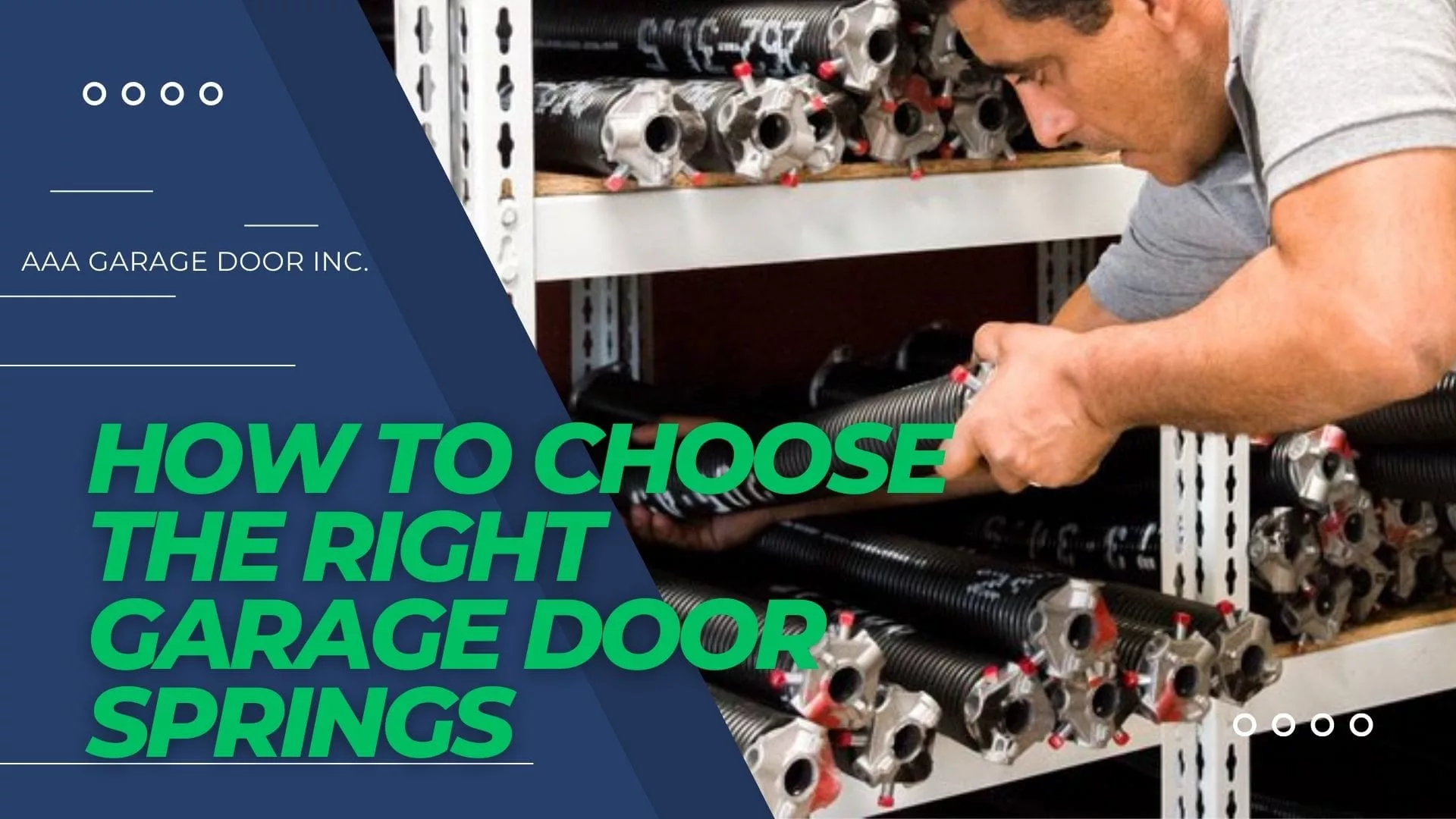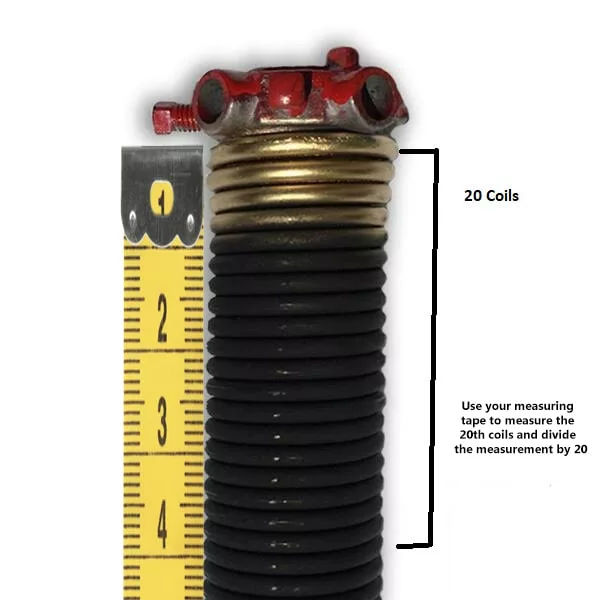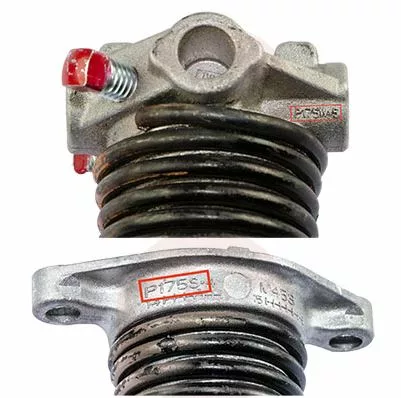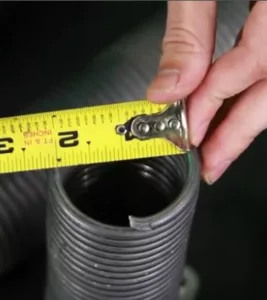Are you struggling to choose the right spring for your garage door? If so, you’re not alone. Selecting the wrong type of spring can cause significant damage to your garage door and put your safety at risk. The good news is that there are some steps that garage door technicians follow to replace your spring or get the right springs for the new garage door installation.
By following these professional key steps, you can choose the right springs for your garage door and ensure that your garage door operates smoothly and safely for years to come.
At AAA Garage Doors Inc, we understand how important it is to choose the right garage door spring choosing the right garage door spring for your garage door is crucial to ensuring the smooth operation and longevity of your garage door system.
That’s why we’ve put together this comprehensive guide to learn everything you have to know about garage door springs in general and especially on
- How to choose the right springs?
- What type of garage door springs?
- How they work?
- How to choose garage door springs?
- Reasons why your garage door springs break.
- Tips on maintenance garage door springs.
Why do you have to choose the right garage door spring?
Safety: You don’t need too big garage door springs or too small, they must provide the exact strength your garage door needs. Garage door springs are under a lot of tension and can be dangerous if they are not exactly the right springs for your garage door they will finally break or burn your garage door opener or damage your garage door panel or even suddenly your garage door will collapse due the malfunction and lead to injuries or losing money on replacement of your garage door. So in fact choosing the wrong size or type of spring can lead to unneeded accidents, injuries, or property damage. the worst scenario It will open your garage door with too much force, rolling up very quickly and compromising its safety. Kids or even unprepared adults could be knocked over by the sudden force when they try to open it.
Performance: The right garage door spring will help your garage door operate smoothly and efficiently. It will ensure that the door opens and closes properly, and it will help to extend the life of your garage door opener because your garage door opener will not work under the high resistance force of the spring.
Cost: Choosing the wrong spring can result in more frequent repairs or replacements for your garage door hinges, cables, and rollers, which can be costly. It’s important to choose a spring that is the right size and type for your garage door to avoid unnecessary expenses.
Convenience: The right garage door spring will make it easier to operate your garage door. If the spring is too weak or too strong, it can be difficult to open or close the door, which can be inconvenient.
Understanding Garage Door Springs Types
Before we dive into the different types of garage door springs, it’s important to know how they work. Garage door springs are responsible for counterbalancing the weight of the door, making it easy to open and close. They work by stretching and contracting as the door moves, absorbing and releasing energy to keep the door in place.
There are two main types of garage door springs: torsion springs and extension springs. Torsion springs are mounted above the door and use torque to lift the door, while extension springs are mounted on the sides of the door and use tension to lift the door.
Torsion Springs
Torsion springs are the most common type of garage door spring in the industry and for a good reason. They offer several advantages over extension springs, including:
Durability: Torsion springs typically last longer than extension springs. Torsion springs generally last between 15,000 and 20,000 cycles, whereas extension springs last up to 10,000 cycles.
Safety: Torsion springs are safer than extension springs because they are mounted above the door, which reduces the risk of injury if the spring breaks.
Better balance: Torsion springs provide better balance for your garage door, which means it will operate more smoothly and efficiently.
Extension Springs
Extension springs once were the most common spring used for garage doors but now are less common than torsion springs, but they can be a good choice for some homeowners that have low headroom of a garage door that will not allow a torsion spring to be installed. However, They offer a few advantages over torsion springs, including:
Cost: Extension springs are generally less expensive than torsion springs.
Easy to install: Extension springs are easier to install than torsion springs.
Choosing the Right Garage Door Spring
Now that you understand the different types of garage door springs, it’s time to choose the right one for your garage door. Here are some steps you can take to ensure you select the right spring:
Determine the weight of your garage door.
The first step in selecting a garage door spring is to determine the weight of your garage door. You can do this by using a bathroom scale or by contacting your garage door services company. Determining the right spring for your garage door requires weighing the garage door with all components installed like hinges, rollers, and struts. Determining the proper spring size requires weighing the garage door with all components installed like struts, rollers, and hinges.
Keep the hard work on us, AAA Garage Doors Inc provides the most reliable and professional garage door spring Repair & Replacement services making homeowners of Miami-Dade & Broward Counties Safe & Secure. With over 380 Reviews & 30000 Happy & Satisfied customers since our company opening in 2009.
View All Reviews
High-Quality Services – Highly Trained Technicians – Affordable & Transparent Prices – Service Warranty – Free Estimation – In-Site Inspection – Emergency Services. Call Us Now at 305-702-0113 Or Schedule a Job.
Determine the type of spring your garage door needs.
Once you know the weight of your garage door, you can determine whether your garage door needs a torsion spring or an extension spring.
How To Choose Garage Door Torsion Springs
to choose the right torsion spring for your garage door, you need to measure the wire diameter, inside diameter, and length of the spring. Precise measurements are crucial as even slight inaccuracies can result in ordering the wrong spring.
- You do not need to make these measurements if the spring that is already installed in your garage door has these measurements printed on it, but given that these readings are not clear so you have first, start with the wire diameter
Wire Diameter By 20 Coils Measurement
To measure the wire diameter, Count out 20 coils and use your measuring tape to measure the 20th coils and divide the measurement by 20. to be precise try to make this calculation multiple times to avoid any mistake because a fraction can lower the accuracy of the springs diameter and results in installing the wrong springs.
Read The Inside Diameter
The inside diameter is often indicated by a letter and number on the winding cone or stationary cone attached to the spring.
Another easy way if your springs are already uninstalled from your garage door and for some reason you don’t have the winding cone or the stationary cone is by head measuring the inside diameter of your springs by using the tape measurement
Left Or Right Hand Wind
It is important to identify if the spring is left or right-hand wind by looking at the end of the spring direction. The left-hand wind spring will point in a clockwise direction, while the right-hand wind one will point in an anticlockwise direction.
Overall spring length
Here are the steps to measure the overall length of a torsion spring:
- Ensure the garage door is closed and disconnected from the opener. Also, make sure you have turned off the power to the garage door opener to avoid accidental activation.
- Locate the torsion spring on the garage door. It is usually located above the garage door and is mounted on a metal shaft.
- Insert a winding bar into one of the winding cone holes of the torsion spring. Make sure the bar is secure and will not slip out.
- Use the winding bar to turn the torsion spring in the direction that would raise the garage door. This will wind the spring and add tension to it. Turn the spring until the coils are tight against each other.
- Measure the length of the spring from one end to the other using a tape measure. This is the overall length of the spring.
- Repeat steps 3 to 5 for the other torsion spring on the garage door.
- Once you have measured the overall length of both torsion springs, you can calculate the total length of the springs by adding the lengths of the two springs together. It’s important to know that this measurement is one that can be slightly off and will not affect the accuracy of the spring needed, but if the total length is any more than 1/2 of an inch off this may result in installing the wrong springs.
It is important to note that measuring torsion springs can be dangerous and should only be done by trained professionals. If you are not comfortable performing this task, it is best to hire a garage door professional to do it for you.
Torsion Spring Material
Finally, know the torsion spring material: torsion springs are typically made from either oil-tempered or galvanized steel. Oil-tempered springs are more durable, affordable, and have a longer lifespan, but they have low protection against rust. Galvanized springs are more Rust-resistant & shiny looking, but they may not last as long and are expensive compared to the oil-tempered ones. In our work operation, we suggest that Miami residents get the Zinc-galvanized torsion springs because will be more durable in humid or tropical climates.
How to choose garage door extension springs
Garage Door Weight: The weight rating of an extension spring determines how much weight it can lift. if you don’t know your garage door weight simply lift your door and slide a bathroom scale under your garage door and type those readings. you can know your garage door weight else from your garage door manufacturer.
Garage Door Height: The length of an extension spring is determined by the height of your garage door.
Extension Spring Type: There are two types of extension springs – open-looped and double-looped. Open-looped springs are less expensive & easy to replace but less durable, while double-looped springs are more expensive and harder to be replaced but more durable.
Common Questions About Choosing Garage Door Springs
Does garage spring size matter
Yes, the size of garage springs does matter. Garage springs are an essential part of a garage door system that helps in lifting and lowering the garage door. As mentioned above the size of the garage springs depends on the weight and size of your garage door.
If the garage springs are too small, they may not have enough tension to lift the garage door, and it may not open properly. On the other hand, if the garage springs are too large, they may have too much tension, which can cause the garage door to lift too quickly or slam shut too hard, leading to safety hazards. So It’s essential to install the correct size of garage springs to ensure that your garage door operates correctly and safely.
What is the Garage Door Springs Color Code
The garage door spring color code system is a method of identifying the strength and size of garage door springs by the color of the paint on the ends of the springs. Color-coding systems typically use one color indicating the numbers printed in the springs of the wire diameter.
The garage door spring color code system was developed by DASMA The garage door industry’s leading organization, to make it easy to find the right garage door springs in an easy non confusion way. This is a standard that has evolved over time as different manufacturers and suppliers use their own color-coding systems. However, this system is widely used in the garage door industry and has become a popular method of determining the strength and size of garage door springs.
Side Note: You will always find the wire diameter number followed with or without the color code but you will not find a garage door spring color code without the wire diameter and that’s because the color code system has multiple wire diameters for one color which will be so hard if the springs wire diameter not printed. You must try the spring and calculate the wire diameter and the strength to know the exact spring strength.
here’s a table for the color codes used for garage door torsion springs and extension springs:
Torsion Spring Color Coding System
| Color Code | Wire Diameter/ Inches |
|---|---|
| White | .531/ .406/ .295/ .218/ .139″Inch |
| Green | .162/ .244/ .319/ .453″Inch |
| Yellow | .135/ .207/ .289/ .394/ .500″Inch |
| Blue | .188/ .263/ .344/ .469″Inch |
| Red | .143/ .225/ .297/ .422/ .563″Inch |
| Brown | .148/ .234/ .307/ .431/ .625″Inch |
| Orange | .120/ .192/ .273/ .363/ .485″Inch |
| Gold | .177/ .250/ .331/ .462″Inch |
| Light Blue | .125/ .200/ .283/ .375/ .490″Inch |
| Tan | .156/ .238/ .313/ .438″Inch |
| Purple | .182/ .257/ .594″Inch |
Extension Spring Color Coding System
Extension springs for garage doors are typically not color-coded in the same way as torsion springs. Instead, color coding systems refer directly to the weight of the garage door the extension spring can handle.
When purchasing replacement extension springs, it’s important to look up the existing spring’s color code, as well as the weight of your garage door. This will ensure that the new spring is the correct size and can properly balance the weight of the garage door.
If you’re unsure about how to look up your extension spring or select a replacement, it’s best to consult a professional garage door technician to ensure safe and proper installation.
Is it safe to buy and then replace your own garage door spring
With proper tools and experience, you will be safe to replace your own garage door springs. As you can see you still need to take a lot of measurements ( Diameter, length and the inner Measurment) after all this you will start on replacing the spring then you have to adjust the tension on the spring, which will a little complicated for the average homeowners, because you have to mess with a lot of tools and compounds and it’s not very practical. We previously had a guide article on how to repair your garage door springs . You have to know that it’s always recommended to hire a professional garage door services company to select the right garage door spring and replace it for you. Every year, there are nearly 13,000 injuries associated with garage doors in the United States, and approximately 1,600 of them occur during maintenance and repair activities. It is highly likely that many of these injuries are sustained by homeowners who attempt tasks without the requisite expertise. Therefore, it is crucial to enlist the help of skilled garage door repair technicians in your local area. By doing so, you can rest assured that your safety is a top priority, giving you peace of mind. if you are worried about the quality of the job in AAA GARAGE DOORS we give a full warranty on our services & clear services costs with free estimation also. Serving Miami-Dade & Broward Counties Since 2009. Call For Consultation (305) 702-0113.
How Much Do Garage Door Springs Cost
The cost of garage door springs can vary based on several factors, including the type of spring, the weight and size of the garage door, and the number of doors.
Materials: The cost of garage door springs can vary depending on the material needed throughout the process. Sometimes it’s required to replace some components on your garage door in order to replace the garage door springs correctly. The cost of materials can range from $150 to $1600. a good example that indicates these situations is when the brackets got broken or a cable snapped or even your cable drum needed to be replaced.
Labor: The cost of labor can also vary depending on the complexity of the job and the location. A professional installation typically costs between $70 to $150 per hour.
The number of Garage Doors: The cost will also depend on how many garage doors you have. If you have a single garage door, you will only need one spring, but if you have a double garage door, you will need two springs. The cost of springs will increase with the number of doors. but you can save the cost of the service fee by having all of your garage door springs replaced at the same time, If multiple garage doors were installed at the same time, they may require replacement at a similar time as well.
Type of Garage Door: The type of garage door you have can also affect the cost of springs. Heavier doors require stronger springs, which can be more expensive. Similarly, if you have a custom or specialty garage door, the springs may be more expensive.
Type of Garage Door Springs: The type of springs you need will also affect the cost. Torsion springs are more expensive than extension springs, but they tend to last longer and require less maintenance.
Overall, the cost of garage door spring replacement can range from $450 without the need for any replacement parts to $1600 with replacement parts. These prices vary and could be not accurate because they mimic the average cost.
It’s important to consult your local professional garage door company to determine the best type of spring for your garage door and to ensure proper installation.
Garage Door Springs Reasons to be broken.
If you are looking for the right garage door spring, you are likely looking for a replacement for your damaged one, so you have to know the reasons that may lead to damage to your garage door spring in order to avoid them in the future.
1- Old Spring: your garage door springs have to be replaced after a certain period of work cycles. torsion springs have up to 20,000 cycles and extension spring has up to 10,000 cycles. A homeowner opens their garage door on average of 3-5 times each day (approximately 1,500 times per year) which means that your garage door springs life expectancy would be 7 to 8 years with proper use conditions & regular maintenance.
2- No Regular Maintenance: In General, you have to know that your garage door system requires an annual maintenance plan to prevent any problems and keep the system functioning probably without the need for expensive repairs and replacement parts. lack of this maintenance plan could affect your garage door spring material and make it vulnerable to rust and corrosion.
Garage Door Springs Maintenance Tips
Once you’ve selected and installed the right garage door springs, it’s important to properly maintain it to ensure it lasts as long as possible.
Here are a few tips for maintaining your garage door spring:
1- Regularly inspect the spring for signs of wear and tear, such as sounds or rust.
2- Lubricate the spring regularly 1 or 2 times every year to reduce friction and prevent corrosion with garage door white lithium or silicone-based spray lubrication.











0 Comments